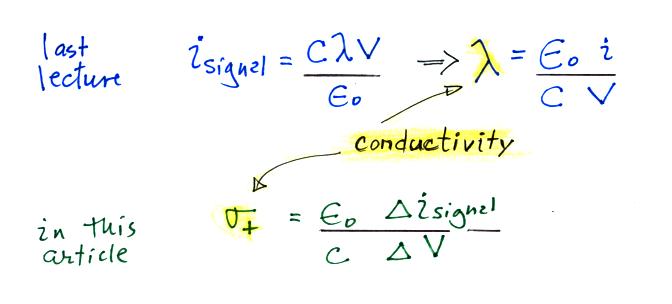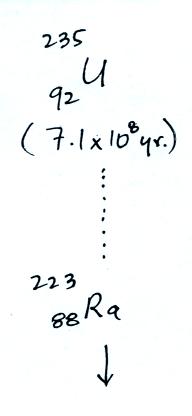Thursday, Feb. 7, 2013
click here to download today's notes in a more printer friendly format
We first need to finish up an example that we didn't have
time for in our last
class. It deals with what happens along an air-cloud
boundary where there
is an abrupt change in conductivity.

Conductivity inside a cloud is lower than in the air outside
a cloud.
This is because the small ions attach to much larger and
much less mobile cloud
particles (water droplets or ice crystals). The E
field must become
stronger inside the cloud so that the current density (the
produce of
conductivity and electric field) stays the same inside and
outside the
cloud. We'll see that layers of charge build up on the
top and bottom
surfaces of the cloud.
We'll try to estimate how much charge is necessary along the
upper surface of
the cloud layer.

We
don't
really know Ez. The current density,
Jz, on the
other hand is constant with
altitude and we assume we know how conductivity changes as
you move across the
cloud-air boundary.

We
can
integrate this equation

So we conclude a layer of
positive charge builds up on the
top edge of the cloud. In a similar kind of way you
could show that a
layer of negative charge would build up on the bottom edge
of the cloud.

The effect of these two layers of cloud is to intensify the
field inside the
cloud. The product of higher field times lower
conductivity inside the
cloud is able to keep the current density equal to the
current density outside
the cloud.
Screening layers that form along the edges of a thunderstorm
effectively mask
the main charge centers inside the cloud.

One of the consequences of this is that it makes it
difficult to use
measurements of E field at the ground to estimate how much
charge builds up in
the main charge centers inside the cloud. We will find
that if you use
sudden abrupt changes in electric field, ΔE
measurements, you can determine the amount and
location of charge
neutralized during lightning discharges. The abrupt
field change occurs
quickly enough that there isn't sufficient time for the
charge screening layers
to rearrange themselves and mask the field change.
The next several figures show measurements of fair weather
conductivity,
electric field, and current density made during a field
experiment in 1978 in
Wyoming. Simultaneous measurements were made with a
variety of different
instruments from different research groups.
Instruments were carried up
to about 30 km altitude by balloon and measurements were
made on the ascent and
often during the descent. Here's a link to the full article
(pdf file).

The list below gives you an
idea of the electrical
parameters that were measured and the various types of
sensors that were used.

Measurements
of
conductivity versus altitude made on two different days are
shown in two
graphs below.

Conductivity
values
range from about 5 x 10-14 mhos/m at 2 km
or so above
the ground to about 1000 times higher near 30 km. The
conductivity values
are from just the positively charged small ions. The
notation
"GC" in the figure refers to "Gerdien
Condenser." The cylindrical capacitor discussed in the
last lecture
would be an example of a Gerdien
condenser type
instrument. Conductivity was estimated using the Isignal/V
slope method described in our last lecture (σ is used
in the
article instead of λ).

All of the measurements are in good agreement with the exccption
of the relaxation time method. This is just the decay
time constant we
derived in a previous lecture.


A
second set of conductivity measurements. These include
both positive and
negative small ions.
The
next
two plots show measurements of electric field versus
altitude.

E field values decrease from a few 10s of volts/meter 2 or 3
km above the
ground to less than 1 V/m near 30 km (note: the
x-axis values are, from
left to right, 0.1, 1.0, 10 and 100 V/m).

The next plot shows the
vertical profile of current density,
Jz. Measurements from two
different days are
plotted together.

Note first of all that current density does stays fairly
constant with altitude
something we expect under steady state conditions (the
x-axis labels, from left
to right, are 0.1, 1.0 and 10 pA/m2).
The
yellow curve is the product of electric field and positive
small ion
conductivity, not a measurement of Jz.
You
would expect the measured Jz
(which includes both positive and negative charge
carriers) to to be roughly
twice the positive conductivity times
electric field, but it isn't. The apparent explanation
for this descrepancy is shown
below (though this seems like too
simple a mistake for the researchers to have made):

One of the Jz
sensors consisted of
two conducting hemispheres insulated from each other.
Charge is induced
on the two hemispheres by the ambient electric field.
The figure above
shows that the sensor is only capturing half of the charge
carries in the
atmosphere and therefore only measuring half of the current
density, Jz.
There might also be some
uncertainty about the effective crossectional
area
(collection area) of the current sensor.
The problem appears to have been corrected in the plot below
which is a
reanalysis of the Wyoming data. The plotted points are
conductivity
(positive and negative polarity) times measured electric
field. The
plotted values cluster around a value of about 2.5 pA/m2
(note again how uniform Jz
is with
altitude). Measured Jz
was
about twice this, about 5.1 pA/m2.

The next graph summarizes measurements from a different
field experiment
conducted in the North Atlantic ocean.

The
plot
shows vertical profiles of E field (highlighted in blue),
measured
positive and negative conductivities (green), and the
calculated current
density (in yellow, the product of positive and negative
conductivity and measured
electric field). The calculated current density values
are clustered
around 1.25 pA/m2,
the measured
total current density was about twice that, 2.35 pA/m2.
Both figures are from W. Gringel,
J.M. Rosen, ande D.J. Hofmann,
"Electrical Structure from 0 to 30
km Kilometers," Ch. 12 in The Earth's Electrical
Environment,
National Academy Press, 1986. (available online at www.nap.edu/books/0309036801/html/)
Now the main part of today's class, we'll start to look at
how small ions are
created. Small ions are the mobile charge carriers
that give the
atmosphere it's conductivity. First something must
ionize air molecules

Then water vapor molecules cluster around the ions to create
"small
ions." Water molecules have a dipole structure as
shown below.

The oxygen atom carries excess negative charge and the
hydrogen atoms positive
charge. Because of this the water vapor molecules
orient themselves
differently around the oxygen and nitrogen ions.
Conceptually this would
look like

More
water
vapor molecules are able to surround the positive ions so
they are bigger
and have slightly lower electrical mobility than the
negative small ions.
The next figure summarizes the processes that ionize air.

Radioactive materials in the
ground emit alpha and beta
particles, and gamma rays. Alpha particles (i.e. a
helium nucleus
consisting two protons and two neutrons) are a strong source
of ionization but
only in the first few cm above the ground. Beta
particles (electrons)
ionize air in a layer a few meters thick. The effects
of gamma radiation
extend of 100s of meters. Cosmic rays are the dominant
source of
ionization everywhere over the ocean and above 1 km over
land.
The table below, not shown in class, gives an idea
of how far these different
types of radiation can travel above the ground and also
typical ionization
rates (ip stands for "ion
pairs"). (from
Chapter 11 in "The Earth's Electrical Environment," National
Academy
of Sciences, 1986 )
|
emission type |
range of travel |
ionization rate [ ip/(cm3
sec) ] |
|
alpha particles |
only a few cm above the ground |
not well known |
|
beta particles |
a few meters above the ground |
0.1 to 10 |
|
gamma rays |
100s of meters above the ground |
1 to 6 |
|
radon |
depends on atmospheric conditions |
1 to 20 at 1-2 m above ground |
|
cosmic rays |
1 to 2 ip/(cm3
sec) near the ground |
|
In addition to being a source of atmospheric ionization,
radon is a signficant health
hazard and is the 2nd leading cause of
lung cancer after cigarettes. Here are links to
articles concerning radon
from the World Health Organization,
Wikipedia,
and the Environmental Protection Agency.
The following table shows a portion of the decay series that
ultimately yield
isotopes of radon.
|
|
|
|
|
|
|
|
|
|
|
|
|
|
|
Because of its relatively short
half life compared to the
age of the earth, all the Neptunium in the ground has
decayed away. Two
isotopes of radon (Rn-222 and Rn-220) have half lives long
enough to be able to
diffuse out of the soil and into the air.
The article from the World
Health Organization
gives a typical outdoor radon concentration of 5 to 15 Becquerels/m3
(Bq/m3
- 1 Becquerel is
one disintegration per second ). We can do a
calculation to see what this
implies in terms of radon concentration and ion pair
production rate.
The rate at which a radioactive material decays is described
by the following
equation

(so
far
in this course we have used λ to represent linear
charge
density, atmospheric conductivity, and now decay
constant).
We can solve the equation above to give

It
is
easy to relate the half life, t1/2, and
the decay constant
λ

The
Rn-222
isotope has a half-life of 3.8 days.

Now that we know the decay constant we'll substitute back
into the decay rate equation
to determine the radon concentration needed to produce an
average outdoors
decay rate of 10 Bq/m3.

(the number density for air, 2.67 x 1019 air
molecules/cm3
is sometimes known as Loschmidt's
number).
This is as far as we got in class but I'll finish the
section so that it
will all be in one place.
We know the decay constant and now have a typical Rn
concentration. Next we can estimate the ionization
rate caused by
radon. We need to know how much energy is contained by
the α-particles
emitted by radon and the energy needed to ionize air.

We can divide these two numbers to determine the number of
ion pairs produced
by each distintegration.
Then we multiply by
the Rn concentration and the
decay constant (which
give the decay rate) to determine the ionization rate.

Radon gas decays into solid particles of polonium, lead, and
bismuth. The
decay series is shown below (source):
- 222Rn, 3.8 days, alpha decaying to...
- 218Po, 3.10 minutes alpha decaying to...
- 214Pb, 26.8 minutes, beta decaying to...
- 214Bi, 19.9 minutes, beta decaying to...
- 214Po, 0.1643 ms, alpha decaying to...
- 210Pb, which has a much longer half-life of 22.3
years, beta decaying to...
- 210Bi, 5.013 days, beta decaying to...
- 210Po, 138.376 days, alpha decaying to...
- 206Pb, stable.
These decay products can attach
to dust particles which are
then inhaled and trapped in the lungs. Since the decay
products are
themselves radioactive, long term exposure can ultimately
lead to lung
cancer. Radon is apparently the 2nd leading cause of
lung cancer in the
US after cigarette smoking and kills about 20,000 people per
year.
Radon concentration indoors can build to levels that are
much higher than
normally found outdoors. An extreme case is mentioned
below.











